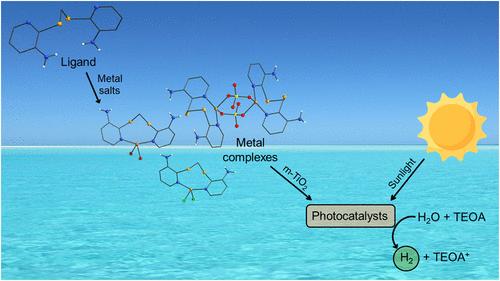硒配位化合物与介孔tio2基制氢光催化剂的结构分析
IF 4.7
2区 化学
Q1 CHEMISTRY, INORGANIC & NUCLEAR
引用次数: 0
摘要
本研究报道了由配体((3-氨基吡啶-2-基)selanyl)甲烷(L)和不同金属中心(CoII, CuI, CuII, ZnII, AgI)合成的10个配位化合物(1-10)。在配体L和相应金属的覆盖溶液中通过缓慢扩散获得了配合物的单晶。通过单晶x射线衍射(SCXRD)确定了它们的晶体结构,并利用光谱、光谱和伏安技术进一步表征了它们的结构。以三乙醇胺(TEOA)为牺牲剂,研究了配合物1 ~ 5、7、10作为介孔二氧化钛(m-TiO2)光催化水光解制氢的助催化剂。结果表明,配合物4、5、7和10增强了m-TiO2的光催化活性,析氢速率至少是标准m-TiO2和P25的4倍。其中,光催化剂m-TiO2-7 (7 = [Cu2(μ-SO4)2L2])的产氢量最高,在6小时的实验中,产氢量约为7800 μmol/g,是纯m-TiO2 (300 μmol/g)的近26倍。这些发现突出了有机硒金属配合物在开发基于非贵金属的新型光催化材料方面的潜力。本文章由计算机程序翻译,如有差异,请以英文原文为准。

Structural Analysis of Selenium Coordination Compounds and Mesoporous TiO2-Based Photocatalysts for Hydrogen Generation
This study reports the synthesis of ten coordination compounds (1–10) derived from the ligand bis((3-aminopyridin-2-yl)selanyl)methane (L) and different metal centers (CoII, CuI, CuII, ZnII, and AgI). Single crystals of the complexes were obtained via slow diffusion from overlaid solutions of ligand L and the corresponding metal. Their crystalline structures were determined by single-crystal X-ray diffraction (SCXRD) and further characterized using spectroscopic, spectrometric, and voltammetric techniques. Complexes 1–5, 7, and 10 were evaluated as cocatalysts of mesoporous titanium dioxide (m-TiO2) for photocatalytic hydrogen production via water photolysis under solar light simulation, using triethanolamine (TEOA) as the sacrificial agent. The results showed that complexes 4, 5, 7, and 10 enhanced m-TiO2 photocatalytic activity, achieving hydrogen evolution rates at least four times higher than standard m-TiO2 and P25. Among these, the photocatalyst m-TiO2-7 (7 = [Cu2(μ-SO4)2L2]) exhibited the highest hydrogen production, reaching approximately 7800 μmol/g over a 6-h experiment–nearly 26 times greater than pure m-TiO2 (300 μmol/g). These findings highlight the potential of organoselenium metal complexes for the development of novel photocatalytic materials based on nonprecious metals.
求助全文
通过发布文献求助,成功后即可免费获取论文全文。
去求助
来源期刊

Inorganic Chemistry
化学-无机化学与核化学
CiteScore
7.60
自引率
13.00%
发文量
1960
审稿时长
1.9 months
期刊介绍:
Inorganic Chemistry publishes fundamental studies in all phases of inorganic chemistry. Coverage includes experimental and theoretical reports on quantitative studies of structure and thermodynamics, kinetics, mechanisms of inorganic reactions, bioinorganic chemistry, and relevant aspects of organometallic chemistry, solid-state phenomena, and chemical bonding theory. Emphasis is placed on the synthesis, structure, thermodynamics, reactivity, spectroscopy, and bonding properties of significant new and known compounds.
 求助内容:
求助内容: 应助结果提醒方式:
应助结果提醒方式:


